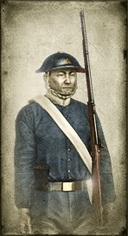
Basic Unit Statistics (can be modified by difficulty level, arts, skills, traits and retainers)
| Recruitment Cost | 770 | |
| Upkeep Cost | 100 | |
| Melee Attack | 4 | 11% |
| Charge Bonus | 10 | 20% |
| Bonus vs Cavalry | 5 | 16% |
| Range | 125 | 19% |
| Accuracy | 30 | 30% |
| Reloading Skill | 30 | 30% |
| Ammunition | 10 | 12% |
| Melee Defence | 2 | 5% |
| Armour | 2 | 13% |
| Morale | 6 | 12% |
Strengths & Weaknesses
- Average accuracy and reload rate.
- Average in melee.
- Weak against cavalry.
- Good morale.
Abilities
- Kneel Fire - The first rank of this unit will kneel to allow the first two ranks to fire simultaneously.
- Suppression Fire - This ability increases reload rate but lowers accuracy. Enemy units hit by suppression fire are slowed and suffer a morale penalty.
Requires
Description
Line infantry are the bulk of an army, doing a good deal of the killing and most of the dying.
Line infantry are the main force of an army making up, as the name suggests, the bulk of a battle line. Equipped and armed in modern, European style, each man has a good quality rifle which gives the unit a reasonable reload speed and good accuracy of fire in most situations. The large bullets fired do an unpleasant amount of damage to enemies. This means that line infantry are best suited to engaging the enemy with fire, and not in close combat where they are no better than other infantrymen. And like other infantry, they can be ridden down by cavalry if they are mishandled or left in an exposed, unsupported position. A wide variety of rifles from many parts of the world were available on the open market by the time of the Boshin war. For most practical purposes on the battlefield there was little to choose between the various rifles on offer. Manufacturers in Britain, France, America and elsewhere competed fiercely to sell their weaponry to anyone who was interested. Governments supported the trade as an adjunct to diplomacy, or conveniently looked the other way in the interests of national profit. The period was, after all, a period of liberal "laissez faire" capitalism where politicians did not consider it the proper business of government to interfere in mercantile matters, even when death was the commodity.